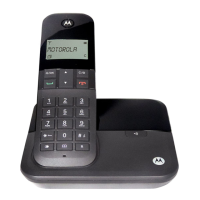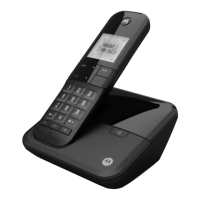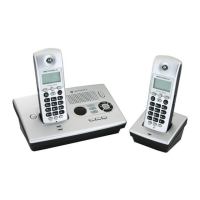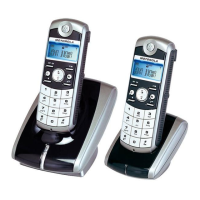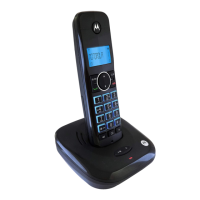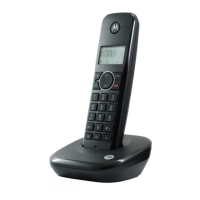Do you have a question about the Motorola ML25255 and is the answer not in the manual?
Information for connecting the equipment to the telephone network and regulatory requirements.
Information regarding FCC rules on radio frequency interference and compliance.
Details on how the telephone company can manage network issues caused by equipment.
Guidelines for safe installation and operation regarding RF radiation exposure limits.
Statement confirming the phone meets FCC standards for hearing aid compatibility.
Details about the phone's compliance with the DECT 6.0 standard.
Specific precautions for handling and replacing batteries in the product.
Guidelines for safe and proper installation of telephone wiring and equipment.
Recommendations for placement and environmental factors during setup.
Steps to physically install the telephone base and handset.
Instructions for inserting the battery pack into the cordless handset.
Procedure for replacing or charging the battery in the cordless handset.
Description of the information displayed on the handset and base screens.
Overview of the menu structure for accessing phone features.
Configuration options for basic phone functions like date, time, and dialing.
Procedure for setting the current date and time on the phone system.
Setting to automatically answer incoming calls without pressing a button.
Feature to automatically answer intercom calls on the handset or base.
Setting the dialing mode (Tone or Pulse) for each line.
Setting the local area code for number formatting and dialing features.
Procedure for registering cordless handsets to the base unit.
Step-by-step guide to register a new cordless handset to the base.
How to de-register a cordless handset via the handset menu.
How to de-register a cordless handset via the base unit menu.
Setting to alert you of an incoming call while on another line.
Procedure for assigning a custom name to each handset.
Setting the display language to English, French, or Spanish.
Adjusting the display contrast for better readability.
Setting the screen backlight to always on or automatic.
Selecting one of eight available ring tones for each line.
Setting the ring volume level for each line, including Off.
Enabling or disabling the audible tones for button presses.
Initiating a call to the voicemail service for a selected line.
Entering the voicemail access number for the service provider.
Setting the answering system to be active or inactive for each line.
Recording short personal messages.
Listening to the pre-recorded outgoing messages.
Recording custom outgoing messages for different scenarios.
Selecting which recorded outgoing message to use for incoming calls.
Defining work and after-hours times for message announcements.
Setting the start time for the business working hours.
Setting the start time for the period outside of business hours.
Configuring the number of rings before the answering system answers.
Setting the maximum duration for recorded incoming messages.
Enabling playback of incoming messages over the speakerphone.
Setting a password to access the answering system remotely.
Steps to place a call using the corded handset connected to the base.
Steps to place a call using the cordless handset.
Instructions for making calls using the speakerphone function on base and handset.
Procedure for making calls using a connected wired headset.
How to answer incoming calls using different modes (handset, speaker, headset).
Procedure for changing active audio modes during a call.
Disabling the ringer for a set period to avoid interruptions.
Redialing the last dialed numbers.
Accessing the list of previously dialed phone numbers.
Saving a redialed number into the phone's directory.
Procedure for transferring an active call to another handset or base unit.
How to answer a call transferred from another extension.
Controlling the ringer volume and turning it on/off for each line.
Adjusting the audio volume for different call modes.
Placing an active call on hold and releasing it.
Setting up 3-way and 4-way conference calls.
How another user can join an active call.
Initiating a 3-way conference call via an intercom connection.
Setting up a 3-way conference call using two telephone lines.
Establishing a 4-way conference call involving both lines and extensions.
Procedure for initiating an intercom call to another handset or base.
How to receive and respond to an intercom call.
Accessing the list of incoming calls with caller ID information.
Saving caller ID information as a new contact in the directory.
Removing a specific incoming call record from the list.
Clearing all stored incoming call records at once.
Redialing numbers directly from the Caller ID records.
Viewing caller ID information for incoming calls while on an active call.
Dialing back CID records when a local area code is set.
Dialing back CID records when no local area code is set.
Steps to create a new contact entry with name and number.
Saving contacts to the dedicated one-touch memory buttons.
Accessing and browsing through stored directory entries.
Accessing contacts stored in the one-touch memory.
Modifying existing contact information in the directory.
Changing contact details for one-touch memory entries.
Transferring directory entries between the base and handsets.
Removing a specific contact from the directory.
Clearing all contact entries from the directory.
Removing a contact from a one-touch memory button.
Making calls using stored directory entries.
Making calls using the one-touch memory buttons.
Dialing a directory contact during an active call.
Dialing a directory contact directly from the directory list.
Dialing a one-touch memory contact during an active call.
Dialing a one-touch memory contact directly from the list.
Activating or deactivating the answering system.
How the system answers calls and records messages.
Listening to calls as they are being recorded.
Recording short personal messages.
Accessing and listening to recorded messages and memos.
Deleting individual messages or all messages from a mailbox.
Instructions for retrieving messages from a remote location.
Information on what happens when the answering system memory is full.
Deleting a message as it is being played back.
Deleting all messages currently stored in a selected mailbox.
Troubleshooting issues related to battery operation and replacement.
Steps to resolve issues when the phone has no dial tone.
Troubleshooting problems with dialing out after getting a dial tone.
Steps to fix issues where the phone is not ringing.
Steps to resolve interference issues causing poor audio quality.
Troubleshooting problems with the intercom feature.
Instructions for cleaning the phone unit safely.
Precautions regarding environmental factors and product usage.
Guidelines for disposing of the product and its batteries.
Details of the product's limited warranty coverage.
Specifies what parts and conditions are covered by the limited warranty.
Defines the scope of warranty coverage, limited to the first purchaser.
Details the actions MZGW will take for warranty claims (repair/replace).
Outlines limitations on implied warranties and liability.
Lists the warranty periods for different product categories.
Details specific conditions and damages not covered by the warranty.
Instructions on how to contact customer service for warranty claims.
Information for connecting the equipment to the telephone network and regulatory requirements.
Information regarding FCC rules on radio frequency interference and compliance.
Details on how the telephone company can manage network issues caused by equipment.
Guidelines for safe installation and operation regarding RF radiation exposure limits.
Statement confirming the phone meets FCC standards for hearing aid compatibility.
Details about the phone's compliance with the DECT 6.0 standard.
Specific precautions for handling and replacing batteries in the product.
Guidelines for safe and proper installation of telephone wiring and equipment.
Recommendations for placement and environmental factors during setup.
Steps to physically install the telephone base and handset.
Instructions for inserting the battery pack into the cordless handset.
Procedure for replacing or charging the battery in the cordless handset.
Description of the information displayed on the handset and base screens.
Overview of the menu structure for accessing phone features.
Configuration options for basic phone functions like date, time, and dialing.
Procedure for setting the current date and time on the phone system.
Setting to automatically answer incoming calls without pressing a button.
Feature to automatically answer intercom calls on the handset or base.
Setting the dialing mode (Tone or Pulse) for each line.
Setting the local area code for number formatting and dialing features.
Procedure for registering cordless handsets to the base unit.
Step-by-step guide to register a new cordless handset to the base.
How to de-register a cordless handset via the handset menu.
How to de-register a cordless handset via the base unit menu.
Setting to alert you of an incoming call while on another line.
Procedure for assigning a custom name to each handset.
Setting the display language to English, French, or Spanish.
Adjusting the display contrast for better readability.
Setting the screen backlight to always on or automatic.
Selecting one of eight available ring tones for each line.
Setting the ring volume level for each line, including Off.
Enabling or disabling the audible tones for button presses.
Initiating a call to the voicemail service for a selected line.
Entering the voicemail access number for the service provider.
Setting the answering system to be active or inactive for each line.
Recording short personal messages.
Listening to the pre-recorded outgoing messages.
Recording custom outgoing messages for different scenarios.
Selecting which recorded outgoing message to use for incoming calls.
Defining work and after-hours times for message announcements.
Setting the start time for the business working hours.
Setting the start time for the period outside of business hours.
Configuring the number of rings before the answering system answers.
Setting the maximum duration for recorded incoming messages.
Enabling playback of incoming messages over the speakerphone.
Setting a password to access the answering system remotely.
Steps to place a call using the corded handset connected to the base.
Steps to place a call using the cordless handset.
Instructions for making calls using the speakerphone function on base and handset.
Procedure for making calls using a connected wired headset.
How to answer incoming calls using different modes (handset, speaker, headset).
Procedure for changing active audio modes during a call.
Disabling the ringer for a set period to avoid interruptions.
Redialing the last dialed numbers.
Accessing the list of previously dialed phone numbers.
Saving a redialed number into the phone's directory.
Procedure for transferring an active call to another handset or base unit.
How to answer a call transferred from another extension.
Controlling the ringer volume and turning it on/off for each line.
Adjusting the audio volume for different call modes.
Placing an active call on hold and releasing it.
Setting up 3-way and 4-way conference calls.
How another user can join an active call.
Initiating a 3-way conference call via an intercom connection.
Setting up a 3-way conference call using two telephone lines.
Establishing a 4-way conference call involving both lines and extensions.
Procedure for initiating an intercom call to another handset or base.
How to receive and respond to an intercom call.
Accessing the list of incoming calls with caller ID information.
Saving caller ID information as a new contact in the directory.
Removing a specific incoming call record from the list.
Clearing all stored incoming call records at once.
Redialing numbers directly from the Caller ID records.
Viewing caller ID information for incoming calls while on an active call.
Dialing back CID records when a local area code is set.
Dialing back CID records when no local area code is set.
Steps to create a new contact entry with name and number.
Saving contacts to the dedicated one-touch memory buttons.
Accessing and browsing through stored directory entries.
Accessing contacts stored in the one-touch memory.
Modifying existing contact information in the directory.
Changing contact details for one-touch memory entries.
Transferring directory entries between the base and handsets.
Removing a specific contact from the directory.
Clearing all contact entries from the directory.
Removing a contact from a one-touch memory button.
Making calls using stored directory entries.
Making calls using the one-touch memory buttons.
Dialing a directory contact during an active call.
Dialing a directory contact directly from the directory list.
Dialing a one-touch memory contact during an active call.
Dialing a one-touch memory contact directly from the list.
Activating or deactivating the answering system.
How the system answers calls and records messages.
Listening to calls as they are being recorded.
Recording short personal messages.
Accessing and listening to recorded messages and memos.
Deleting individual messages or all messages from a mailbox.
Instructions for retrieving messages from a remote location.
Information on what happens when the answering system memory is full.
Deleting a message as it is being played back.
Deleting all messages currently stored in a selected mailbox.
Troubleshooting issues related to battery operation and replacement.
Steps to resolve issues when the phone has no dial tone.
Troubleshooting problems with dialing out after getting a dial tone.
Steps to fix issues where the phone is not ringing.
Steps to resolve interference issues causing poor audio quality.
Troubleshooting problems with the intercom feature.
Instructions for cleaning the phone unit safely.
Precautions regarding environmental factors and product usage.
Guidelines for disposing of the product and its batteries.
Details of the product's limited warranty coverage.
Specifies what parts and conditions are covered by the limited warranty.
Defines the scope of warranty coverage, limited to the first purchaser.
Details the actions MZGW will take for warranty claims (repair/replace).
Outlines limitations on implied warranties and liability.
Lists the warranty periods for different product categories.
Details specific conditions and damages not covered by the warranty.
Instructions on how to contact customer service for warranty claims.
| Brand | Motorola |
|---|---|
| Model | ML25255 |
| Answering System | Yes |
| Caller ID | Yes |
| Frequency | 2.4 GHz |
| Number of Handsets | 1 |
| Answering Machine | Digital |
| Intercom | Yes |
| Type | Cordless Phone |
| Expandable | Yes |
